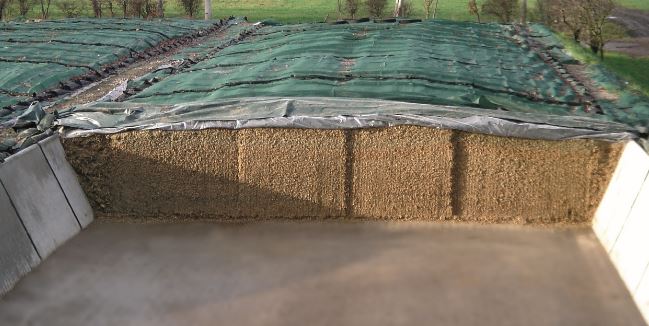A Carmarthenshire dairy farm is improving silage quality by making small changes to clamp management.
Increasing clamp density has been a focus at Nantglas, a Farming Connect demonstration site at Talog, where milk producer Iwan Francis runs two block calving herds.
During a recent Farming Connect open day at the farm, independent silage specialist Dr Dave Davies, of Silage Solutions, said the target density should be 700kg of fresh matter per cubic metre which, depending on the silage dry matter (DM), is equivalent to approximately 220kg of dry matter per cubic metre.
At Nantglas, a density of 800kg has been achieved, and even on the edges and on the top (which are considered the vulnerable zones of the clamp), it was 694kg.
A compactor had been used to increase DM density and speed up compaction. This, said Dr Davies, had not only resulted in better density and aerobic stability – and therefore fewer losses – but studies had also shown a 10% fuel saving compared to a tractor.
“The denser the silage is filled into the clamp, the quicker the oxygen is removed,” he said.
A homofermentative additive was used since research data has shown a benefit to animal performance, unlike the use of mixed homo/heterofermentative silage additive products, said Dr Davies.
“One of the issues with using a homofermentative additive can be aerobic spoilage, but there has been no spoilage at Nantglas,” he said.
When selecting additives, Dr Davies advised farmers to ask if there have been independent trials to prove the benefits to livestock.
At feeding out, he recommends measuring the density in various parts of the clamp face to test for any weaknesses.
This, he said, would probably correspond with poorer quality silage and possibly heating and aerobic spoilage, which reduce quality and intakes.
To test, take a sharp stainless steel metal tube that is around 5cm in diameter and 75cm long and has a sharp end.
Screw this into the clamp face to take a core sample; weigh that sample in kilogrammes and the depth of the hole in metres.
To establish the density, divide the weight by the result of multiplying the radius of the hole squared by its depth and by 3.14; the target is 700kg fresh matter per cubic metre.
“If the density is low in regions of the clamp, more attention is needed when consolidating these areas in future”, said Dr Davies.
Help keep news FREE for our readers
Supporting your local community newspaper/online news outlet is crucial now more than ever. If you believe in independent journalism, then consider making a valuable contribution by making a one-time or monthly donation. We operate in rural areas where providing unbiased news can be challenging. Read More About Supporting The West Wales Chronicle


























